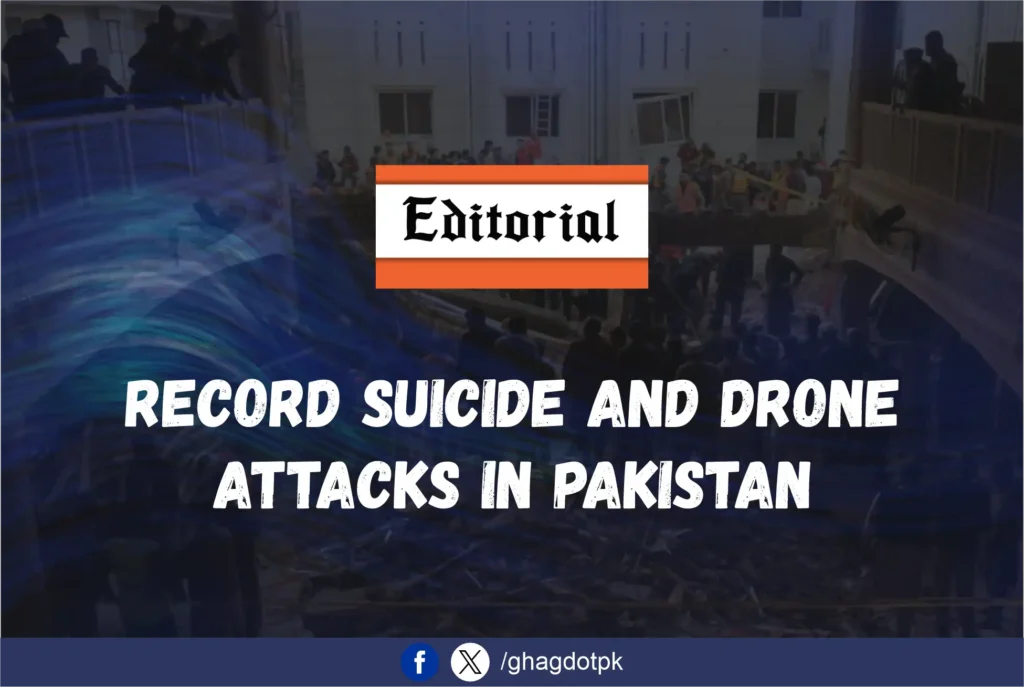In Pakistan, suicide attacks started in 2002. The practice of what the Taliban continued to refer to as “fidayeen attacks” was made official and used as a weapon in the resistance and war that was mentioned. Neither NATO nor Pakistan’s security forces were able to implement this war plan in Afghanistan successfully. In contrast to Pakistan, the US and NATO had more advanced technology. As a result, the incidence of suicide and fidayeen attacks remained low there. However, due to a lack of resources, Pakistan was unable to regulate it, which is why attacks on the Pakistani military as well as on public and political figures suffered the most, and the series intensified once more in 2023. There were roughly 23 suicide attacks in Khyber Pakhtunkhwa, 11 in Balochistan, and 2 in Islamabad in 2023. This figure has increased because it was more than 15 during the first three months of 2024. Of these, the attack on forces in Mirali North Waziristan in March 2024 proved to be the most dangerous, in which seven security personnel were targeted. In response, Pakistan had to formally launch air strikes in two provinces of Afghanistan, Khost and Paktika, for the first time. In the same month, a suicide attack on a Chinese convoy in Bisham resulted in the loss of six lives and Pakistan had to face severe pressure because the attack itself jeopardized the future of many other projects, including CPEC, between Pakistan and China, and the attack was taken so strongly at the state level that an emergency meeting of the National Security Committee was held under the chairmanship of Prime Minister Shahbaz Sharif the day after the attack, which was attended by the heads of all major intelligence agencies, as well as Army Chief General Asim Munir, and reviewed various possibilities for the protection of Chinese personnel and residents. In the year 2003-4 General Pervez Musharraf, the former president of Pakistan at the time, was assaulted three times in Rawalpindi, Islamabad. Fortunately, he survived because of well-thought-out plans, but one of the attacks was so serious that it left him injured and prevented him from doing anything for a week. The leader of Tehreek-e-Taliban Pakistan’s suicide squad, Qari Hussain, once informed the late Rahimullah Yousafzai, a well-known writer covering similar subjects, that the TTP employed at least 500 suicide fighters. While the history of suicide attacks in South Asia encompasses not only Pakistan and Afghanistan but also India and Sri Lanka, Pakistan has been the site of the greatest number of suicide assaults, with Afghanistan ranking second. Not only have Kashmiri jihadi groups used the weapon against Indian forces in the occupied valley, but earlier in 1991, a devastating suicide attack by a Sri Lankan group killed dozens of people, including Congress party chief and former prime minister Rajiv Gandhi, during an election rally in India. There have also been instances of this kind in Sri Lanka. In Pakistan, the number of suicide attacks rose in 2005-6. The largest attack in this regard happened to soldiers practicing outside a military fort in the Dargai area of Khyber Pakhtunkhwa; as a result, hundreds of soldiers were hurt and dozens of soldiers died. Dr. Shamsher Ali Khan, an ANP member of the provincial assembly, and his colleagues were targeted during one such operation on the occasion of Eid. Later, in the Peshawar suicide attacks, numerous people lost their lives, including Senior Provincial Minister Bashir Ahmed Bilour, Commandant Frontier Constabulary Safwat Ghayur, and numerous other notable figures. This lethal weapon was not only used in Khyber Pakhtunkhwa but also several other cities, including Karachi, Rawalpindi, Islamabad, Lahore, and Quetta.
During one such operation, in the 2007 election campaign, former Prime Minister Benazir Bhutto was targeted in Rawalpindi, resulting in the deaths of dozens of others, including her. Benazir Bhutto was planned to be targeted during her visit to Peshawar during the same campaign, but it was later canceled and she was targeted in Rawalpindi. It is also strange because on the day Benazir Bhutto was assassinated in Liaquat Bagh Rawalpindi, Afghan President Hamid Karzai was visiting Islamabad, and Benazir Bhutto held his final formal meeting with Karzai before his death. According to some sources, at this meeting, the Afghan president not only cautioned them to be vigilant based on intelligence inputs. He also spoke with them about the prospects and strategy for counterterrorism, as her election win was guaranteed but she was killed. Attempts were made to spread conspiracy theories about the attack, but the attack was undoubtedly carried out by the TTP as Mufti Noor Wali Mehsud has written full details about it in his book Revolution Mehsud. The people who were arrested later also gave information about the entire planning. In this background, it can be said that suicide bombers were used in both the incidents in which two important leaders of Pakistan and India and former Prime Ministers Benazir Bhutto and Rajiv Gandhi were assassinated over two and a half decades. Although Benazir Bhutto’s death was caused by a bullet, the real credit went to the suicide squad and the technique. Attempts were made to spread conspiracy theories about the attack, but the attack was undoubtedly carried out by the TTP as Mufti Noor Wali Mehsud has written full details about it in his book “Inqilab-e-Mehsud”. The people who were arrested later also gave information about the entire planning. In this background, it can be said that suicide bombers were used in both the incidents in which two important leaders of Pakistan and India and former Prime Ministers Benazir Bhutto and Rajiv Gandhi were assassinated during the last two and a half decades. Although Benazir Bhutto’s death was caused by a bullet, the real credit went to the suicide squad and the banned terrorist organization. According to a detailed investigation within Pakistan, over 200 suicide attacks occurred following 9/11, within the Khyber Pakhtunkhwa region accounting for 67% of the total.
While Pakistan’s security forces faced a serious challenge and were targeted in numerous attacks, there was a debate in Pakistan’s religious circles, particularly among the Ulema, about the Sharia status of suicide attacks based on the Jihad ideologies, as well as whether such attacks on Muslims in an Islamic country are permissible from an Islamic standpoint. There were differing views on this, but the Taliban proceeded to defend the entire process using their reasoning. Prominent scholar Javed Ahmad Ghamidi and his colleagues, among others, began to criticize the Taliban’s stance on some related topics, including suicide attacks, while other scholars, including former MNA and prominent cleric Maulana Hasan Jan from Khyber Pakhtunkhwa and eminent religious leader Muhammad Khan, also spoke out. All of them declared suicide attacks against the teachings of Islam. As a result, Maulana Hasan Jan was brutally killed. Maulana Shirani was repeatedly attacked, and Allama Ghamidi was forced to leave the country.
Many religious scholars in Pakistan declared suicide attacks to be against Islam in 2015. Approximately 1800 distinguished scholars also declared Pakistan to be an Islamic state and condemned the actions of Tehreek-e-Taliban Pakistan and other groups as anti-Sharia. However, these scholars not only persisted in their actions by rejecting the fatwas and arguments of these scholars but also the scholars who made such anti-Taliban declarations and fatwas came under heavy criticism for being perceived as representatives of state entities and many embraced death. There are inconsistencies about jihad as well as ideological and professional divides in this context, but there are two schools of thought when it comes to security. Furthermore, suicide attacks have been nothing short of a nightmare for the armed forces of all nations, and despite their best attempts, this weapon has proven unbreakable.
Narrative Warfare: The Ongoing Diplomatic Struggle
By Farman Ullah The diplomatic battle between Pakistan and India has intensified, with both countries engaging in a war of narratives. After facing off on






